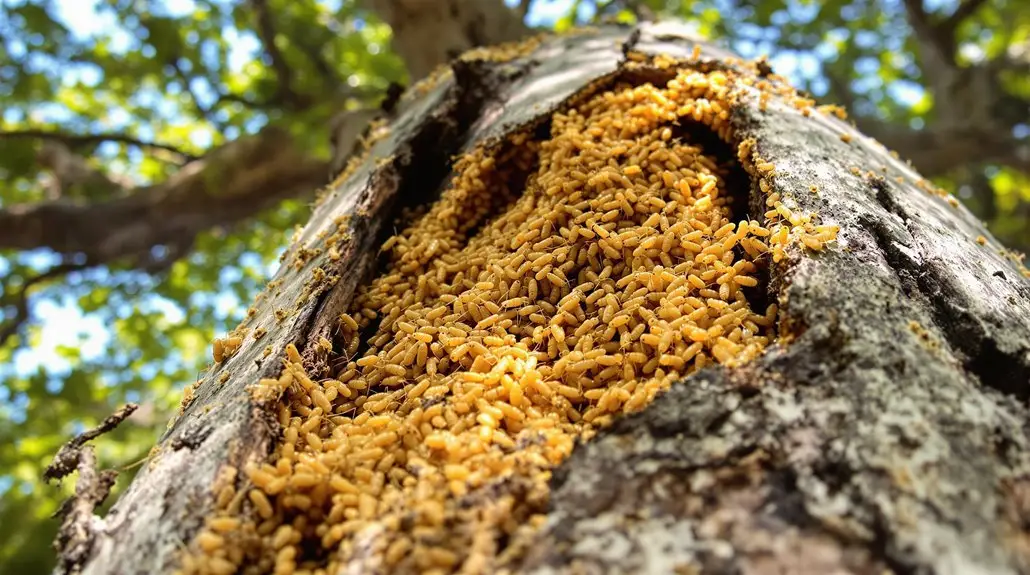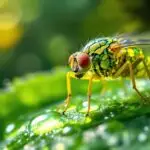Are Our Trees Safe? A Termite Threat in Southeastern Florida
Coptotermes gestroi, the Asian subterranean termite, considerably threatens the urban tree canopy in southeastern Florida. Its rapid colony expansion and aggressive feeding habits lead to the decline of essential tree species and disrupt local ecosystems. The economic impact is severe, with damage costs surmounting $1 billion annually in the U.S., particularly affecting historic structures and cultural heritage. Researchers focus on control strategies and the ecological consequences of these infestations, highlighting the need for awareness surrounding this invasive species. Discovering more about their behaviors can further inform mitigation efforts.
Key Insights
- Coptotermes gestroi, the Asian subterranean termite, poses a significant threat to urban trees in southeastern Florida, leading to structural damage and tree mortality.
- Infestations can result in over $1 billion in structural damage costs annually in the USA, impacting urban tree canopies and property values.
- The termite’s preference for humid environments contributes to the decline of valuable tree species, such as *Pinus elliottii* and *Quercus virginiana*.
- Effective control strategies include above-ground bait stations and soil treatments, which target their foraging behavior and colony elimination.
- Ongoing research focuses on understanding species distribution, genetic relationships, and methods to mitigate economic losses due to termite damage.
Overview of *Coptotermes Gestroi
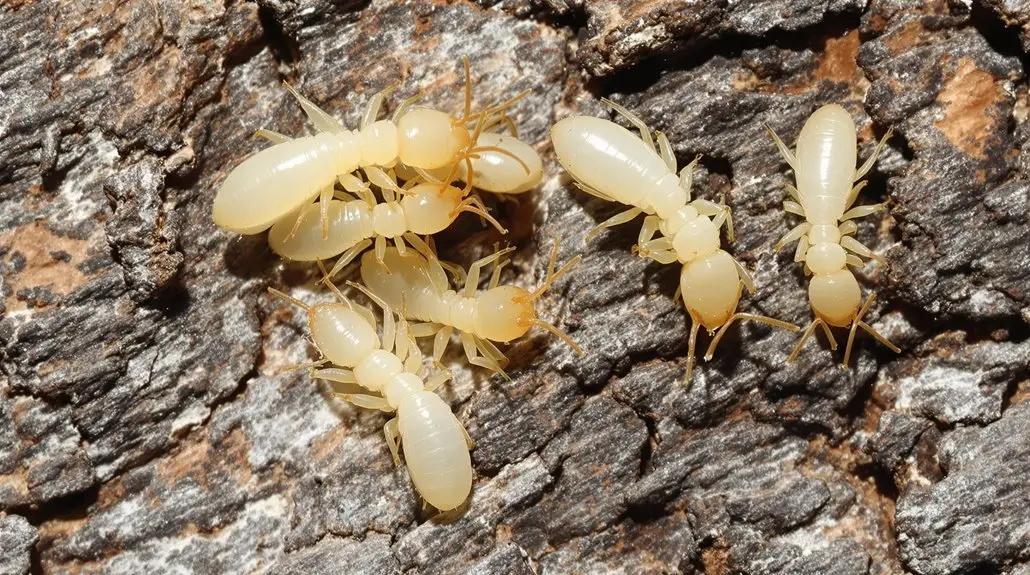
Coptotermes gestroi, commonly known as the Asian subterranean termite, presents a considerable concern for urban environments, particularly in Florida, where its destructive feeding habits threaten local trees. This species features a caste system consisting of workers, soldiers, and reproductive individuals, with colonies established by a male and female pair. Workers, smaller and cream-colored, engage in foraging and caring for the young, while soldiers, identifiable by their reddish-brown heads and large mandibles, defend the colony. Queens exhibit remarkable longevity, living up to 20 years and laying as many as 1,000 eggs daily. Preferring humid environments, *C. gestroi* targets various tree species, including mango and citrus, thereby considerably impacting urban forest health and structure. The invasive nature of *C. gestroi* has led to it being considered the most economically important subterranean termite in Southeast Asia, causing significant damage to wooden structures. Effective preventive measures such as regular inspections can help mitigate the risks posed by this termite species.
Distribution and Expansion in Florida
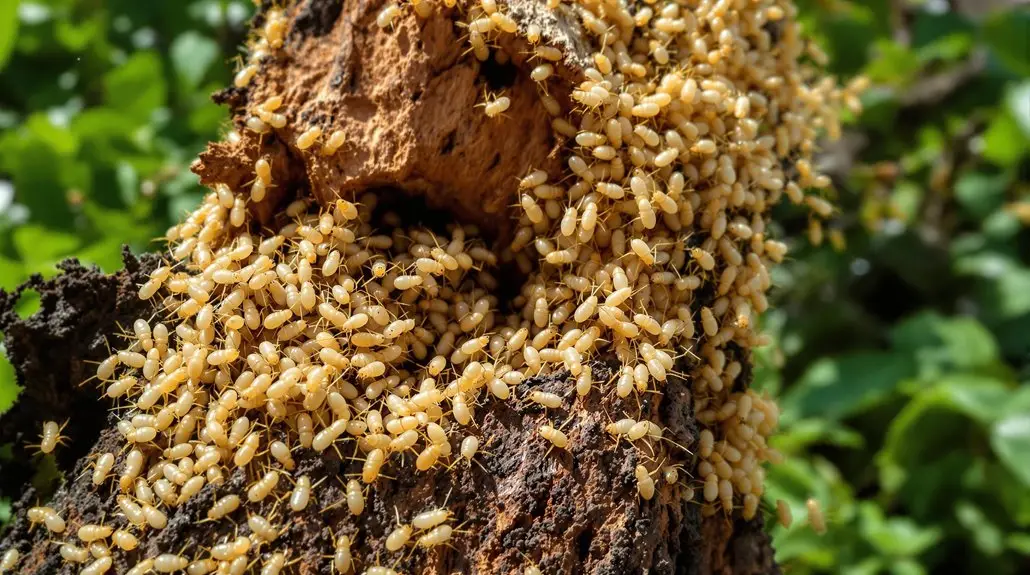
The presence of *Coptotermes gestroi* in Florida has raised significant concerns regarding its distribution and potential for expansion, particularly within urban areas. First discovered in Miami in 1996, this species currently inhabits tropical southeastern Florida, with confirmed collections in four counties and eight cities. Importantly, both *C. gestroi* and *C. formosanus* share overlapping distributions in Dade and Broward counties. Urban development heavily influences these distributions, as infestations often arise from shipboard introductions and land-based commodities like railroad ties. Urban areas near marine dockages are particularly vulnerable, with most infestations occurring within one kilometer of these sites. Consequently, early detection and monitoring within structures are essential for managing the threat posed by *C. gestroi* to the urban tree canopy. Recent studies indicate that both species have been known to colonize boats and ships, which facilitates their dispersal. To combat these infestations, implementing comprehensive pre-construction termite services can provide essential protection for new developments.
Economic and Environmental Consequences
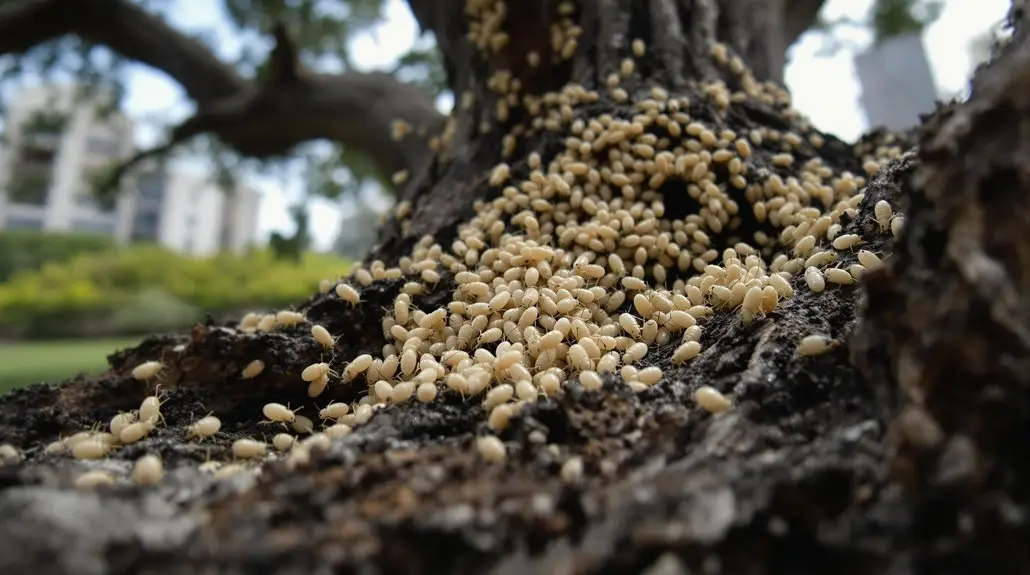
When you consider the economic and environmental consequences of *Coptotermes gestroi*, it becomes clear that their impact extends far beyond individual properties. The financial burden from structural damage alone can exceed billions annually, while the infestations considerably threaten urban trees, leading to long-term disruptions in local ecosystems. As these trees suffer, the broader implications for biodiversity and essential ecosystem services become increasingly apparent, highlighting the urgent need for effective management strategies. Implementing a year-round protection plan can significantly mitigate the risks associated with termite infestations.
Structural Damage Costs
Structural damage caused by termites, particularly *Coptotermes gestroi*, presents significant economic and environmental challenges, impacting both urban infrastructure and natural ecosystems. In Southeast Asia, termite-related damage amounts to approximately $400 million annually, while in the USA, costs exceed $1 billion for managing and repairing damage from subterranean termites, including *C. gestroi*. This genus threatens the forestry industry, negatively affecting lumber quality and economic viability. Additionally, historic structures face irreversible damage, resulting in financial losses and impacts on cultural heritage. Agricultural operations also suffer, as wooden structures essential for farming become compromised. Effective detection and control strategies, including specialized monitoring tools and baiting systems, are essential for mitigating these costs and preserving both economic resources and environmental integrity. The alarming spread of *C. gestroi* in southeastern Florida highlights the urgent need for effective management strategies.
Urban Tree Impact
Although the presence of *Coptotermes gestroi* poses significant challenges to urban forestry, understanding its economic and environmental impacts is vital for effective management. Infestations lead to the decline and death of valuable trees, particularly *Pinus elliottii*, while *Quercus virginiana* suffers damage to its heartwood, compromising structural integrity. This vulnerability was evident when hollowed oak trees collapsed during Hurricane Irma, posing risk to safety. The economic ramifications include reduced property values and increased costs for monitoring and treatment. Additionally, infestations alter urban forest composition and contribute to decreased biodiversity, as specific tree species are targeted. As these termites thrive in urban settings, managing their impact is essential for preserving both economic interests and environmental health.
Ecosystem Disruption Effects
Ecosystem disruption effects stemming from *Coptotermes gestroi* infestations greatly impact both economic and environmental dimensions, as these termites not only damage urban trees but also alter the delicate balance of local ecosystems. The financial costs associated with their destruction are substantial, leading to loss of historic structures and increased maintenance expenses for property owners. Additionally, these infestations reduce native biodiversity, as specific tree species decline, further altering the ecosystem. Soil erosion becomes a concern due to weakened tree stability, while essential ecosystem services, such as nutrient cycling and carbon storage, are compromised. Consequently, these disruptions threaten agricultural productivity and diminish the aesthetic value of landscapes, ultimately affecting tourism and local economies considerably.
Biological Characteristics and Behavior
Understanding the biological characteristics and behavior of *Coptotermes gestroi* is essential for managing its impact on urban trees in Florida. You’ll find that this species exhibits a highly organized colony structure, where castes perform specific roles, and its feeding habits reveal a preference for cellulose-rich materials, including both decaying wood and living trees. Additionally, by examining their reproductive patterns, which are influenced by environmental conditions, you can grasp how these termites expand their colonies and pose a significant threat to urban landscapes. The dispersal flights of *C. gestroi* typically occur at dusk or night, highlighting their potential for rapid colonization. Effective management of *C. gestroi* can be achieved through targeted treatments like Drywood Termite Spot Treatments that minimize disruption to the environment.
Colony Structure Overview
- Reproductive Caste: Queens and kings produce and fertilize eggs, ensuring future generations.
- Worker Caste: Workers care for the young, feed fellow termites, and maintain the intricate tunnel systems.
- Soldier Caste: Soldiers protect the colony from threats, armed with enlarged heads and mandibles.
- Alates: These winged reproductives swarm to establish new colonies, contributing to population expansion.
Feeding Habits Explained
Coptotermes gestroi exhibits distinct feeding habits that greatly influence its role as a pest in urban environments, particularly in Southeastern Florida. This termite primarily targets moist wood and soil, thriving in subtropical conditions. Its foraging behavior involves creating intricate, branched tunnels to access a variety of cellulose-containing materials, including dead trees and wooden structures. Significantly, it requires moist conditions for ideal feeding and is susceptible to desiccation. While its feeding rate is lower than that of Coptotermes formosanus, it adapts well to urban settings. The termite focuses on the first discovered food source but will exploit multiple options simultaneously, demonstrating a flexible foraging strategy that enables it to effectively invade both natural and managed habitats.
Reproductive Patterns Insight
– Reproductive individuals (alates) engage in evening flights to mate and establish new colonies. The ability of these alates to thrive in urban environments is crucial for the spread of Coptotermes gestroi. – Neotenics, which are non-dispersing reproductive individuals, step in when primary reproductives fail, ensuring continuity. – Workers maintain the colony by foraging and caring for young, while soldiers, recognized by their reddish-yellow heads, defend against threats. – The queen begins laying 15-30 eggs shortly after mating, marking the start of colony growth and development.
These intricate dynamics illustrate the resilience and adaptability of Coptotermes gestroi.
Detection Methods for Infestations
While many traditional detection methods for termite infestations, such as stake surveys and in-ground monitoring stations, have proven ineffective for identifying Coptotermes gestroi in specific regions like southeastern Florida, researchers have turned their focus to more reliable techniques that increase detection efficiency. Above-ground bait stations, particularly those using noviflumuron baits, have emerged as effective tools for detecting C. gestroi activity, enabling more targeted monitoring. Additionally, analyzing tunnel geometry is essential, as C. gestroi constructs thin, highly branched tunnels that can indicate infestation extent. Electronic sensors are also gaining traction, allowing for automated monitoring that minimizes the need for frequent manual inspections. By integrating these advanced methods, you can enhance detection strategies tailored to the unique environmental factors influencing termite behavior. Furthermore, utilizing eco-friendly solutions such as those offered by No Tent Termite Service can contribute to more sustainable pest management practices.
Control Strategies and Challenges
Effective control strategies are essential for managing infestations of *Coptotermes gestroi*, especially given the unique challenges presented by this invasive termite species. Effective methods include:
- Baiting with noviflumuron, which can eliminate colonies within 4-9 weeks.
- Soil treatments, similar to those used for *C. formosanus*, that provide effective control.
- Above-ground bait stations, proven to be more effective than in-ground stations for monitoring.
- Environmental considerations, as temperature and humidity greatly impact infestation levels.
However, challenges arise due to sympatric distributions with *C. formosanus*, requiring careful management to avoid hybridization. Additionally, different strategies may be necessary for structural versus tree infestations, complicating control efforts. Understanding these factors is vital for successful management. Moreover, the use of in-ground termite bait stations offers a sustainable option for protecting urban tree canopies from infestations.
Research Directions and Future Studies
As researchers continue to investigate *Coptotermes gestroi*, they are focusing on several critical areas that could illuminate the species’ behavior, ecological impact, and management strategies. One major direction involves studying its species distribution, particularly in Florida, to better understand its spread and potential threats to urban tree canopies. Genetic studies are also essential, as they reveal relationships among populations that may inform dispersal patterns. Additionally, researchers are examining the fitness and adaptation of *C. gestroi*, especially regarding its ability to hybridize with *C. formosanus*, which could enhance its invasiveness. Understanding its complex foraging behavior and ecological role will further guide management efforts. These research efforts aim to mitigate economic losses and protect urban landscapes from termite damage, especially considering the estimated annual economic impact of subterranean termites is $32 billion. Furthermore, the presence of multiple species of termites in Florida highlights the urgency of these studies.
Public Awareness and Education Initiatives
Identify signs of infestation, such as mud tubes and carton nests, to recognize termite activity promptly. Engage in regular inspections, encouraging residents to monitor their properties for potential infestations. Participate in seasonal awareness campaigns, particularly around March, when swarming signals new threats. Utilize interactive resources, like termite distribution maps, to track local infestations effectively. Additionally, understanding the role of termite species in the ecosystem can help highlight the importance of managing pest populations while preserving beneficial species. Implementing eco-friendly solutions for termite control can further protect the community and environment.
Together, these initiatives empower communities, fostering proactive engagement in protecting urban tree canopies against these destructive pests.
Final Thoughts
Understanding the Threat of Coptotermes gestroi
In summary, *Coptotermes gestroi* poses a significant threat to urban tree canopies in southeastern Florida, with estimates suggesting that this invasive termite species can cause damage exceeding $1 billion annually across the United States. Researchers continue to explore detection methods and control strategies, emphasizing the importance of public awareness and education initiatives. As urbanization progresses, understanding the behaviors and impacts of this pest will be essential for preserving Florida’s unique ecological landscape and protecting valuable tree resources.
The Urgent Call to Protect Our Green Canopy
To combat the growing threat of Coptotermes gestroi, we urge residents of South Florida to take proactive measures. Partner with NaturePest Holistic Pest Control to safeguard your trees and preserve the beauty of our urban landscapes. Together, we can create a healthier environment for our community and future generations. Don’t wait until it’s too late—act now to protect our precious tree canopy!

